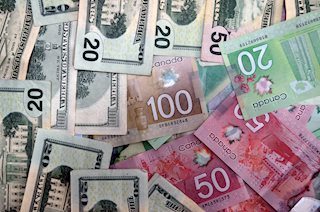USD/CAD stays near 1.3700 after expected decline in US inflation
|
- USD/CAD changes little near 1.3700 after the release of the US CPI report for July.
- The inflation data showed that year-on-year price pressures decelerated expectedly.
- The BoC is expected to cut interest rates for the third time in a row.
The USD/CAD pair hovers near the round-level support of 1.3700 in Wednesday’s New York session. The Loonie asset changes little after the release of the United States (US) Consumer Price Index (CPI) report, which shows that price pressures slowed expectedly in July.
The CPI report showed that annual headline and core inflation, which doesn’t include volatile items such as food and energy, decelerated by one-tenth to 2.9% and 3.2%, respectively. Monthly headline and core inflation rose by 0.2%.
An expected decline in the US inflation has offered cushion to the US Dollar (USD), which was on track to revisit seven-month low. The US Dollar Index (DXY), which tracks the Greenback’s value against six major currencies, finds support after posting an intraday low at 102.36.
The inflation report has boosted confidence that price pressures are on track to return to the desired rate of 2%. However, expectations of a Federal Reserve (Fed) big interest-rate cut announcement have eased. The CME FedWatch tool shows that the likelihood of a 50-basis point (bp) interest-rate reduction has eased to 41.5% from 54.5% after the release of the July’s inflation report.
Meanwhile, the Canadian Dollar (CAD) has faced mild selling pressure as Oil prices have corrected gradually after a one-way rally. The Oil prices have dropped as investors look for fresh developments on conflicts between Iran and Israel in the Middle East. It is worth noting that Canada is the leading exporter of Oil to the US and lower prices of black gold weighs on the Canadian Dollar.
This week, the Loonie will be majorly guided by the market speculation for Bank of Canada (BoC) rate cuts amid absence of top-tier economic data. Investors expect that the BoC could extend its policy-easing cycle in September to prevent labor market from worsening further.
Economic Indicator
Consumer Price Index ex Food & Energy (YoY)
Inflationary or deflationary tendencies are measured by periodically summing the prices of a basket of representative goods and services and presenting the data as the Consumer Price Index (CPI). CPI data is compiled on a monthly basis and released by the US Department of Labor Statistics. The YoY reading compares the prices of goods in the reference month to the same month a year earlier. The CPI Ex Food & Energy excludes the so-called more volatile food and energy components to give a more accurate measurement of price pressures. Generally speaking, a high reading is bullish for the US Dollar (USD), while a low reading is seen as bearish.
Read more.Last release: Wed Aug 14, 2024 12:30
Frequency: Monthly
Actual: 3.2%
Consensus: 3.2%
Previous: 3.3%
Source: US Bureau of Labor Statistics
The US Federal Reserve has a dual mandate of maintaining price stability and maximum employment. According to such mandate, inflation should be at around 2% YoY and has become the weakest pillar of the central bank’s directive ever since the world suffered a pandemic, which extends to these days. Price pressures keep rising amid supply-chain issues and bottlenecks, with the Consumer Price Index (CPI) hanging at multi-decade highs. The Fed has already taken measures to tame inflation and is expected to maintain an aggressive stance in the foreseeable future.
Information on these pages contains forward-looking statements that involve risks and uncertainties. Markets and instruments profiled on this page are for informational purposes only and should not in any way come across as a recommendation to buy or sell in these assets. You should do your own thorough research before making any investment decisions. FXStreet does not in any way guarantee that this information is free from mistakes, errors, or material misstatements. It also does not guarantee that this information is of a timely nature. Investing in Open Markets involves a great deal of risk, including the loss of all or a portion of your investment, as well as emotional distress. All risks, losses and costs associated with investing, including total loss of principal, are your responsibility. The views and opinions expressed in this article are those of the authors and do not necessarily reflect the official policy or position of FXStreet nor its advertisers.